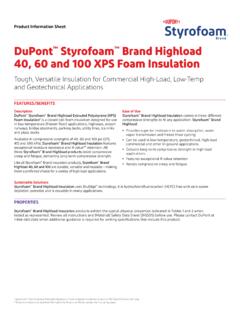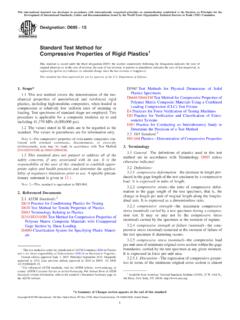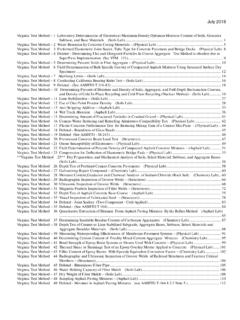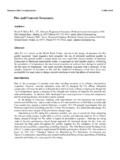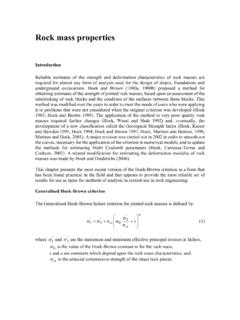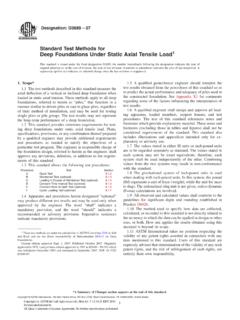Transcription of PROPERTIES OF THE POLYURETHANE (PU) LIGHT FOAMS
1 Wit Witkiewicz*, Andrzej Zieli ski** *Ship Design and Research Centre, Department of Materials Science, Corrosion and Environment Protection, Gda sk, Poland, **Gda sk University of Technology, Department of Materials Science and Engineering, Gda sk, Poland, PROPERTIES OF THE POLYURETHANE (PU) LIGHT FOAMS ABSTRACT The report presents results of laboratory investigations made on the PU FOAMS . Mechanical PROPERTIES of FOAMS have been measured in compression tests for two FOAMS of 16 kg/m3 and 62 kg/m3 density, and in tension and shearing tests for foam of 62 kg/m3 density. PU FOAMS have shown anisotropic PROPERTIES as measured in parallel and perpendicular direction to the foam rise. Three directional values of Poisson s ratios in tension have been determined for foam of 62 kg/m3 density. The fatigue tests have been made for foam of 62 kg/m3 density, at 10,000 cycles of loading and unloading of mass cargo barge.
2 Reduction in buoyancy for both FOAMS after 7 and 30 days of immersion in water has been shown to occur to some extent. The burning tests were performed for foam of 62 kg/m3 density showing good behaviour.. Key words: polyurethanes, PROPERTIES INTRODUCTION The polyurethanes (PU) FOAMS are widely used as insulating and core materials for furniture, cooling and freezing systems, in housebuilding, shipbuilding etc. The use of rigid FOAMS is resulted from their low heat conduction coefficient, low density, low water absorption, relatively good mechanical strength [1,2]. The PU FOAMS have been applied also as core materials of sandwich constructions with steel plates, in building the industrial houses, warehouses, sport houses, fruit stores, carrying freezers and cold stores, where they have to fulfill both insulating and mechanical requirements [3,4].
3 There is a number of references illustrating the effects of foam density on mechanical PROPERTIES of PU FOAMS [2,5]. The data are largely dependent on foam producer, as used substrates and production technology decide on intrinsic structure and foam density, and in such a manner - on capacity to carry mechanical loads. The data on fatigue PROPERTIES of PU FOAMS are generally lacking. This project has been aimed at complex evaluation of various PROPERTIES : static and dynamic mechanical PROPERTIES , physical PROPERTIES (density and water absorption) and chemical PROPERTIES (flame spreading rate burning test) of the foam EDULAN A/S produced by the Danish enterprise. Such foam is considered to be used as a core material in production of the LIGHT barges for shallow waters, designed in the framework of the UE INBAT project.
4 36 ADVANCES IN MATERIALS SCIENCE, Vol. 6, No. 2 (10), October 2006 The PU foam created in situ between steel plates will undergo the mechanical stress of different form and level. Therefore, the various tests have been performed, including among others: fatigue tests simulating loading and unloading of coal and ore; tests of water absorption as to measure the change in mechanical PROPERTIES after damage of side and bottom plating of barge; burning tests to assess the danger for crew, resulting from possible fire. EXPERIMENTAL Two kinds of FOAMS were investigated: (a) POLYURETHANE foam EW 045-45-20-K delivered as of 62 kg/m3 density, and (b) POLYURETHANE foam EW 045-14-20-C delivered as of 16 kg/m3 density. Apparent density of PU FOAMS was determined according to ISO 845 Standard. The compression, tensile, shearing and fatigue tests were performed with the MTS No.
5 1012 machine. The force/deformation relation were computer-recorded and processed using ExMTS software developed by the Ship Design and Research Centre. The linear regression procedure was applied for determination of elasticity modules. The compression tests were carried out according to ISO 844 Standard in parallel and perpendicular direction to the foam rise. Specimens dimensions were 100x100x50 mm. The used equipment is shown in Photo 1. The compression strength and rigidity modulus were measured for both FOAMS . For the foam of 62 kg/m3 density compressive PROPERTIES were determined in a 10 kN force range, 15 mm displacement range and a testing speed of 5 mm/min. The modulus of elasticity was determined within the load range of 2. 5 kN. For the foam of 16 kg/m3 density compressive PROPERTIES were determined in a kN force range, 15 mm displacement range and at a testing speed of 5 mm/min.
6 Approximate modulus of elasticity was determined within the load range of kN. Photo 1. Equipment used in compression tests of FOAMS Wit Witkiewicz, Andrzej Zieli ski: PROPERTIES of the POLYURETHANE (PU) LIGHT FOAMS 37 The tensile tests were performed according to ISO 1926 Standard in parallel and perpendicular direction to the foam rise. The equipment used and shape of specimens cut out from foam blocks are shown in Photo 2. The tensile strength and Young modulus were measured for foam of 62 kg/m3 density only. Tensile PROPERTIES were determined in a kN force range and at a testing speed of 5 mm/min. The strain was measured with an extensometer MTS of a 50 mm gauge length and a mm strain range. The modulus of elasticity was determined within the strain range of Photo 2.
7 Equipment (left) and specimens (right) used in tension tests Shearing tests were performed according to ASTM C 273-94 Standard in parallel and perpendicular planes to the foam rise. Dimensions of specimens were 300x50x25 mm. The used equipment is shown in Photo 3. The shear strength and shear modulus were measured only for foam of 62 kg/m3 density. The test specimens were rigidly supported by steel plates bound to the foam with epoxy resin adhesive. The shear PROPERTIES were determined at a 10 kN force range and a testing speed of 1 mm/min. The displacement of steel plates was measured with an extensometer MTS of a 50 mm gauge length and mm strain range. The shear modulus was determined within the travel of an extensometer of mm. The extensometer was taken off when the displacement of plates had reached 1 mm and test was continued up to the moment of foam rupture, registering the force and displacement of piston of a testing machine (stroke).
8 The Poisson s ratios were performed for foam of 62 kg/m3 density, on the basis of EN ISO 527-1:1996 Standard. The specimens of dimensions 75x50x50 mm in parallel and perpendicular planes to the foam rise were cut out. The used flat-wise tension test setup according to the ASTM C 297-94 Standard is shown in Photo 5. The facings of the test specimen were bound to the loading blocks with epoxy resin adhesive. The Poisson s ratios were determined at a testing speed of 1 mm/min. The directional 38 ADVANCES IN MATERIALS SCIENCE, Vol. 6, No. 2 (10), October 2006 deformations of PU foam during tensile were measured simultaneously by means of two extensometers fixed on the sides of specimen at the following parametrs: - travel of the extensometer 1, in a longitudinal direction, measured with an extensometer MTS of a 50 mm gauge length and a mm strain range.
9 - travel of the extensometer 2, in a transverse direction, measured with an extensometer MTS of a 25 mm gauge length and a mm strain range. The relation of / was directly determined within strain range of mm, using the linear regression method and taking into account the data registered during the test by the extensometer 1 and 2. The following factors were determined for: 12 - longitudinal direction parallel to the foam rise and transverse direction perpendicular to the foam rise, 22 - longitudinal direction perpendicular to the foam rise and transverse direction perpendicular to the foam rise, 21 - longitudinal direction perpendicular to the foam rise and transverse direction parallel to the foam rise. Photo 3. Equipment used in shearing tests (left) and for determining the Poisson s ratio (right) The tests of reduction in buoyancy of FOAMS after immersion in fresh water for a period of 7 and 30 days, 1 m under water level, were made according to IMO recommendations (IMO DE 41/11/11 Section Evaluation And Test Report For Buoyancy Material ).
10 The dimensions of the specimens were 150x150x150 mm. The samples buoyancy was determined using an electronic balance having the g accuracy of reading. The balance was equipped with a specimen clamping setup, designed in accordance with the ISO 2896 Standard. The setup was hung under the balance. The balance was calibrated after immersion in water. The foam specimen buoyancy was measured directly after placing it in the set. The fatigue (loading unloading) tests were carried out only for foam of 62 kg/m3 density. The dimensions of the specimens were 100x100x50 mm, and test temperature 26 2oC. It was assumed that specimens be loaded in the direction perpendicular to the foam rise, in the least beneficial direction concerning the strength aspect. Each specimen was subjected to the test at 10,000 load cycles number.

